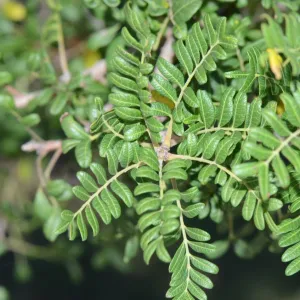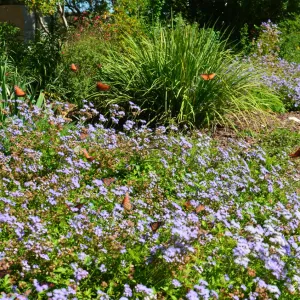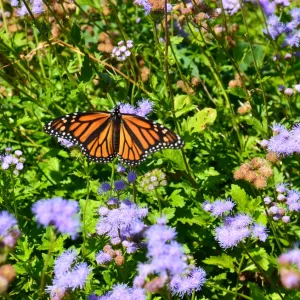By Delmar Cain
by Delmar Cain — Boerne Chapter, Native Plant Society of Texas
Published in the Boerne Star on November 8, 2013
It is the fall of the year, the weather is cooler and it is time to think about trees. Fall color presages falling leaves and rings the starting bell for falling limbs, if you are into tree trimming. But fall is also the best time to plant trees. More moisture and less heat give newly planted trees a fighting chance to grow the strong roots that are needed to help make it through the tough times that are going to come.
A tree that is native to Val Verde County, Texas and northern Mexico should be able to endure rough times. For that reason the Boerne Chapter of the Native Plant Society of Texas (NPSOT) selected the Texas pistachio or Texas pistache (Pistacia mexicana) as its NICE (Natives Instead of Common Exotics) Plant of the Month for November.
Growing along the limestone cliffs of gullies and ravines in well-drained soils, this tree prefers full sun, but may accept partial sun. It is drought resistant, but it does need excellent drainage. If you have a hillside location, consider locating a Texas pistachio there. It might be at risk in a flat area with heavy rain over an extended period.

As a member of the Sumac Family, one can expect a bit of color at some point in the year. For the Mexican pistachio (another of its common names) that color comes in the spring. Although it is evergreen, the new leaves it puts on in the spring are reddish, but turn green with age.
The female Texas pistachio also blooms with small, white flowers in the spring and summer. After the flowers the female tree produces clusters of red berries or drupes, which turn black as they dry. As this is not a common tree, planting a male tree in the area would be wise.

Most Mexican pistachio trees will not grow taller than 10 to 20 feet. Occasionally in just the right spot it might grow taller. The Wildflower Center in Austin and several other web sources indicate that it is deer resistant. Comments from local NPSOT members indicate that one would do well to protect the new growth for several years.
Finding a Texas pistachio this fall might require some searching. I have been told that some growers will have this tree available in the spring at the Mostly Native Plant sale sponsored by the Cibolo Nature Center. If you do search for the tree, remember that the Texas pistachio and the Chinese pistachio are not identical. The Chinese pistachio is definitely not native to Texas.
If you are interested in seeing a Texas pistache, you will find one at the Boerne Civic Center at 820 Adler Road in Boerne. It will be on your left in the second median as you drive toward the circle at the front entrance.
After you have seen the Texas pistache. take additional time to look at the other native plants in the beds around the Center. Gayle Stakes, the Center Supervisor, and her helpers have done a wonderful job of maintaining many of the native plants that were planted with the original landscaping.
In the beds you will find autumn sage (Salvia greggii), blue mistflower (Conoclinium coelestinum), and fall aster (Symphyotrichum oblongifolium). There are also Texas mountain laurel (Sophora secundiflora), yaupon (Ilex vomitoria), Spanish oak (Quercus buckleyi) and some of the prettiest and most productive big-tooth maples (Acer grandidentatum) in Boerne.


On one of the days that I was there, the healthy and vibrant blue mistflower plants were dotted with queen butterflies. A handful of monarch butterflies were sipping nectar and adding weight for their journey to Mexico. Several species of sulphur butterflies were visiting the autumn sage.
You will be doing yourself a favor if you go by in the next few days. If you happen to see them, tell Gayle, and the crew, James Hester, David Pellosma and Billy Cass, that you appreciate their work in keeping Boerne beautiful with native plants.
Arbor Week (November 4-9) is still being celebrated in Boerne. Check out the remaining events on the Cibolo Nature Center website at: http://www.cibolo.org/calendar One event on November 9th will detail how to plant and care for trees. What a timely event for the fall and this tree-planting time.
